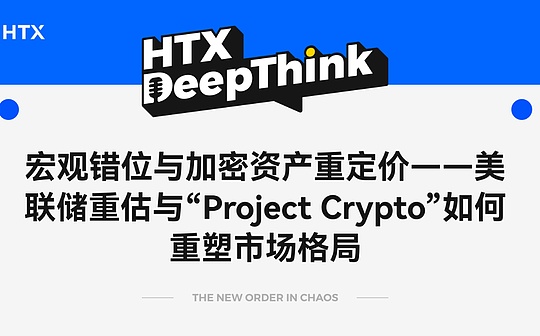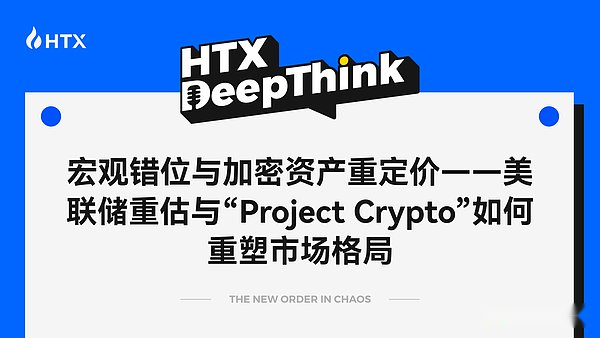

As macro signals were released for several consecutive days at the end of July, the crypto market was at a crossroads of policy game and regulatory reconstruction.This column,HTX ResearchChloe (@ChloeTalk1) interprets and analyzes the unexpected weakening of non-farm employment in the United States, the revaluation of the Federal Reserve’s policy pricing, and the change in the regulatory paradigm caused by the SEC’s launch of “Project Crypto”, pointing out that core assets such as Bitcoin are receiving dual support from macro and institutional dividends.
Non-agricultural shifts, policy expectations have changed drastically
After the FOMC meeting in July, the Federal Reserve maintained the interest rate target range of 5.25%-5.50%, and refused to give a timetable for interest rate cuts, which once made the market worried about “long-term high interest rates.”Affected by this, the 10-year U.S. Treasury yield surged to 4.24%, the US dollar index rose to 100 again, gold fell below $3,270, and Bitcoin then fell to the $116,000 range, and on-chain activity fell simultaneously.However, the July non-agricultural employment report released three days later unexpectedly “collapsed”: only 73,000 new jobs were created, far lower than the consensus expectation of 180,000; at the same time, the total employment in May and June was revised down by about 90% (129,000), and the labor market “systematic overestimation” instantly emerged.The sudden chill of macro fundamentals triggers a drastic repricing of interest rates: the probability of CME FedWatch’s rate cut soared from 38% to 82%, and the bets for the two rate cuts before the end of the year rose to 64%.The 10-year yield fell below 4.10%, gold rebounded $40 to $3363 in a single day, while Bitcoin fell to a low of 112,000 due to panic in the recession narrative.
However, in terms of overall economic resilience, multiple structural data show that the United States is still in the “slower growth” rather than a “system recession” range: as of the second quarter of 2025, household debt accounted for only 98% of disposable income, significantly lower than the peak of the 2008 crisis by 133%; the credit card default rate dropped slightly from 2.7% to 2.5% this year, and the leverage safety cushion of residents is still thick.Retail sales stabilized in the range of 2.8%-3.1% year-on-year, with consumption supported by the wealthiest 10% of families – this group controls 72% of the country’s wealth and contributes nearly half of the expenditure.The corporate side is also stable. The latest financial reports of JPMorgan Chase and Bank of America show that commercial loans still maintain a year-on-year growth rate of 5%-7%, and bad debt provisions have not increased significantly, indicating that there is no systematic credit reduction.Historical experience shows that combinations like “regressive employment margin + decline in inflation stickiness” are often the prelude period when monetary policy changes from tight to loose, and risky assets enter the window of “high volatility and liquidity game”; core assets such as BTC and gold are favored by funds for hedging value, while altcoins are subject to valuation compression and leverage sales risks.
Regulatory breaks the deadlock, and on-chain finance benefits
More disruptive changes come from the regulatory side.On July 31, the new chairman of the Securities and Exchange Commission, Paul Atkins, launched the “Project Crypto”, announcing that the US finance will be “full on the chain” and the compliance model will be rewrite with regulatory loosening, innovative exemptions, and safe harbor mechanisms.He clearly pointed out that most crypto assets should not be recognized as securities, and automated market making and on-chain lending are “non-intermediated financial activities” and should be approved by the system.This move has released huge policy dividends for the DeFi protocol: highly autonomous agreements such as Uniswap, Aave, and Lido have obtained legalization expectations, and the token valuation logic that has been suppressed by the “shadow of securities” for a long time has ushered in a repair window.
Atkins also proposed the “Super-App” license blueprint – allowing operators to integrate traditional securities, crypto assets, pledge and lending services under one license, which gave Coinbase and Robinhood the first to take the lead; Robinhood has taken the lead by taking advantage of the acquisition of Bitstamp to launch the U.S. stock tokenized transaction in the form of ERC-20, and Coinbase has laid out the prototype of “one-stop on-chain Chiaxin” through the Base chain.The draft regulatory bill also named ERC-3643 as a reference template for RWA tokenization. The standard has built-in ONCHAINID identity and permission management, and can natively embed KYC/AML rules to pave the way for trillion-level assets such as real estate and private equity to safely go on the chain.
More importantly, the SEC plans to revise the Howie Test that has been used for decades, establishing disclosure exemptions and safe ports for native economic activities on chains such as airdrops, ICOs, and staking, and truly write “issuance of coins does not equal securities” into regulatory guidelines.This means that the entrepreneurial team no longer needs to “detour through Cayman” or block US users. Level 1 funds are expected to return to the local area, and the on-chain venture capital cycle may restart from the United States.
Triple resonance, valuation logic reshaping
Combined with macro-loose repricing and the transfer of regulatory paradigm, Bitcoin’s current role as “global anti-inflation anchor + policy game tool” has been further consolidated.From a strategic perspective, BTC and ETH are still the core assets that the market is currently concerned about. The market is continuing to observe the changing trend of BTC’s market share and the exchange rate deviation of stablecoins against BTC to judge the potential direction of capital allocation.For altcoins and high leverage strategies, market volatility may intensify when the US dollar strengthens in a phased manner or long-term interest rates return above 4.4%.At the same time, DeFi protocol tokens with compliance clarity and real income models, as well as RWA themed assets surrounding the ERC-3643 standard, may enter a new round of valuation reshaping cycle driven by policy dividends and actual implementation, becoming the direction for market participants to observe in the medium term.Overall, the global crypto market is standing at the starting point of the triple resonance of “macro slowdown + liquidity easing + regulatory upgrade” – the valuation anchor of core assets is moving upward, and the institutional dividends of on-chain finance are opening up the next round of structural opportunities.
Note: The content of this article is not an investment opinion, nor does it constitute an offer, solicitation or recommendation for any investment product.
About HTX DeepThink
HTX DeepThinkIt is a crypto market insight column created by Huobi HTX, focusing on the global macro trend, core economic data and crypto industry hotspots, injecting new thinking power into the market, and helping readers in the unpredictable crypto world.Finding order in chaos”.
About HTX Research
HTX Research is an exclusive research department under Huobi HTX. It is responsible for in-depth analysis of a wide range of fields such as cryptocurrencies, blockchain technology and emerging market trends, writing comprehensive reports, and providing professional evaluations.HTX Research is committed to providing data-based insights and strategic forward-looking, playing a key role in shaping industry perspectives and supporting smart decision-making in the digital asset space.With rigorous research methods and cutting-edge data analysis, HTX Research has always been at the forefront of innovation, leading the development of industry ideas, and promoting an in-depth understanding of changing market dynamics.








